About
Special News
Logan's Page
Jacoby's Page
Our Travel Index
Tracks Ahead Related Trips
Contact
Japan - 2006
Originally written for the Tracks Ahead website
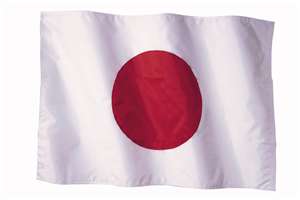 |
David & his German friends explore the trains of central Japan. |
October 13
I'm not going to be able to report much on the Shinkansen (Japanese high speed trains) segment, as most of the shooting was done while I was still traveling to get here. John & Gail said that the trains are extremely fast, smooth, and quiet. I'm sure I'll have more to report as we move through this trip. But for now, I am here. It was the usual slog (13 hrs) over on JAL. The fact that I had an empty seat next to me was the only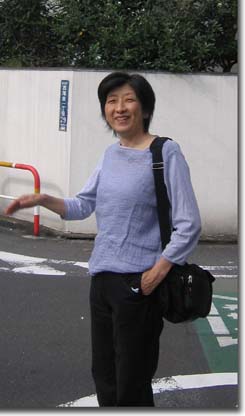 saving
grace. I watched the movie "Cars" three times. It's cute, but not
worth that many repetitions. The sleeping pills did not knock me out as
I had hoped. I did get through the airport just fine, picked up the
cell phones, exchanged money, and got to the hotel. The latter was a
long ride. It's a big city, with more rivers than I had realized. The
roads are smooth and cars are generally smaller (as are the traffic
lanes). Here, the SUV is an anomaly. Dead tired, I met everyone for a
Japanese dinner, where I had to take off my shoes, and put in a
locker. The exit was different from the entrance, which cuts down on
door congestions. I met our fixer (production coordinator and ever
helpful guide) and guide, Nikki Izumi, and we discussed a bit of the
shoot for tomorrow.
saving
grace. I watched the movie "Cars" three times. It's cute, but not
worth that many repetitions. The sleeping pills did not knock me out as
I had hoped. I did get through the airport just fine, picked up the
cell phones, exchanged money, and got to the hotel. The latter was a
long ride. It's a big city, with more rivers than I had realized. The
roads are smooth and cars are generally smaller (as are the traffic
lanes). Here, the SUV is an anomaly. Dead tired, I met everyone for a
Japanese dinner, where I had to take off my shoes, and put in a
locker. The exit was different from the entrance, which cuts down on
door congestions. I met our fixer (production coordinator and ever
helpful guide) and guide, Nikki Izumi, and we discussed a bit of the
shoot for tomorrow.
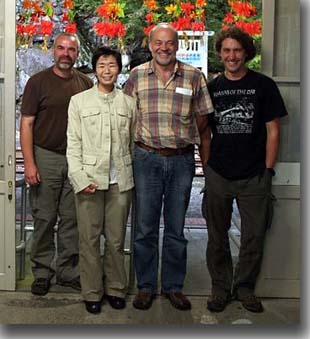 I
should also point out that the Tracks Ahead crew is here with a German
team from Eisenbahn Romantik. Please meet my friends Andreas
Stirl, guide Toshiko Sakaue, Hagen von Ortloff, Dirk Greiffert, and (not
pictured) Klaus Eckert and Wolfgang Schumacher. We have worked
together for several
I
should also point out that the Tracks Ahead crew is here with a German
team from Eisenbahn Romantik. Please meet my friends Andreas
Stirl, guide Toshiko Sakaue, Hagen von Ortloff, Dirk Greiffert, and (not
pictured) Klaus Eckert and Wolfgang Schumacher. We have worked
together for several
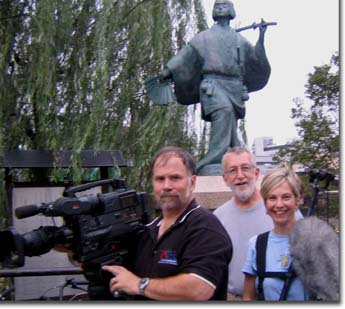 years
on joint projects, and thought that this project would allow us to share
expenses, footage, and maximize the coverage of Japan to our various
audiences. On the U.S. side, we have John McKay, myself, Gail
Grzybowski, and the Geisha statue.
years
on joint projects, and thought that this project would allow us to share
expenses, footage, and maximize the coverage of Japan to our various
audiences. On the U.S. side, we have John McKay, myself, Gail
Grzybowski, and the Geisha statue.
Before I start our journey, I'd like to put in a plug for our sponsors. This trip was made possible by the Japanese National Tourist Organization, though both their New York and Frankfort offices. They, Japan Airlines, the Ministry of Tourism and the Visit Japan Campaign, have allowed us to undertake this opportunity to show American and German audiences the railroads of Japan and how easy they are to use. I'd also give a plug to International Motion Picture Corporation (IMPC) who provided the coordinators in Japan.
October 14 - Kato Hobby Center
Today I started my portion of the Japan trip with a visit
to the Kato (Sekisui Kinzoku Co) showroom and central office. They have
their showroom and a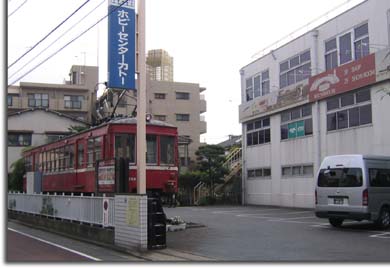 hobby store in the Shinjuku-ku District of Tokyo. It was about a 45
minute drive from the hotel, and the same sense
hobby store in the Shinjuku-ku District of Tokyo. It was about a 45
minute drive from the hotel, and the same sense
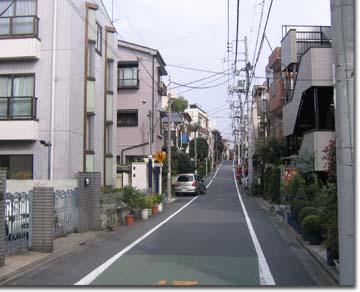 of
density was present this morning. The streets are generally very
narrow, and each intersection looks the same in all directions. I would
get lost here very easily. And, it may explain why practically every
car has a big screen GPS mounted on the dash. The hobby center was
pretty easy to spot, with an interurban car out in front, but other than
that and the sign, it looks just like a gazillion other buildings. We
talked with President Hiroshi Kato, his father Yugi (who started the
business), and their public relations director, Kazuhiro Asano.
of
density was present this morning. The streets are generally very
narrow, and each intersection looks the same in all directions. I would
get lost here very easily. And, it may explain why practically every
car has a big screen GPS mounted on the dash. The hobby center was
pretty easy to spot, with an interurban car out in front, but other than
that and the sign, it looks just like a gazillion other buildings. We
talked with President Hiroshi Kato, his father Yugi (who started the
business), and their public relations director, Kazuhiro Asano.
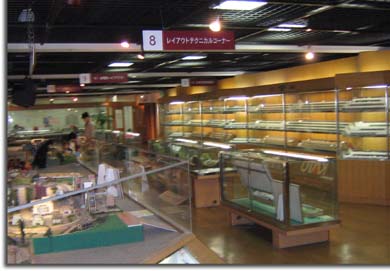 In addition to the showcases of their product line, the second floor of
the building has many small layouts. You can use some of these layouts
to test your new purchase, as one small boy was doing during our visit.
They had one that was set up with Digitrax controller for the same
purpose. The third floor is a hobby shop and a meeting room, where we
talked with representatives of a Japanese modular railroad club. They
focus on American railroading, for the reason that everything in Japan
is so
In addition to the showcases of their product line, the second floor of
the building has many small layouts. You can use some of these layouts
to test your new purchase, as one small boy was doing during our visit.
They had one that was set up with Digitrax controller for the same
purpose. The third floor is a hobby shop and a meeting room, where we
talked with representatives of a Japanese modular railroad club. They
focus on American railroading, for the reason that everything in Japan
is so
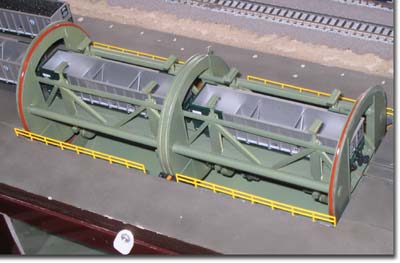 dense
that the modeling of the US allows them to see vast expanses. One of
the members had built an operating N gauge rotary dumper that was rather
impressive. We finished late in the afternoon, and realizing that we
needed more Shinkansen runbys, asked the club members for viewing
spots. They were only to happy to oblige! So off our driver
dense
that the modeling of the US allows them to see vast expanses. One of
the members had built an operating N gauge rotary dumper that was rather
impressive. We finished late in the afternoon, and realizing that we
needed more Shinkansen runbys, asked the club members for viewing
spots. They were only to happy to oblige! So off our driver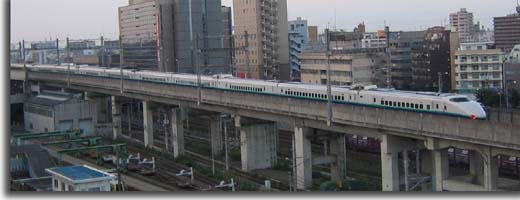 went, past some really nice older homes and temples, to some high angle
back roads. This really is a train watchers paradise. There's a
Shinkansen every three minutes or so, and that is all intermixed with
local passenger trains. From there it was off to the Ginza area, which
is the high end shopping section of Tokyo. I wanted neon, and we passed
tons of it. Our guide, Nikki, said that it is rather out of fashion to
put
went, past some really nice older homes and temples, to some high angle
back roads. This really is a train watchers paradise. There's a
Shinkansen every three minutes or so, and that is all intermixed with
local passenger trains. From there it was off to the Ginza area, which
is the high end shopping section of Tokyo. I wanted neon, and we passed
tons of it. Our guide, Nikki, said that it is rather out of fashion to
put
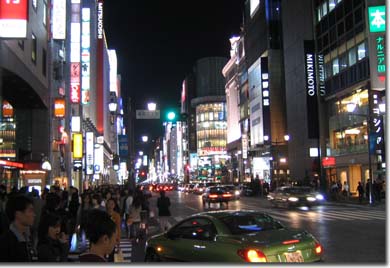 up
the splashing neon for which Tokyo has become so noted. But there was
plenty to see anyway. Further Japanese impressions are: It's quiet.
For a large city, there are no honking horns, no boom cars, no blaring
music. There are lots of people everywhere, traffic is dense, and,
well, with 12 million people, the place is just big. The houses are
small, and there is more vertical living than horizontal. Gardens are
tiny, and may be on a rooftop. I'd love to see behind some of the
closed doors, as I can imagine that some of these places are fabulous.
But everything s compact, and there is a real thrust toward solar roof
panels, small efficient cars, and maximum use of space. And the neon is
pretty impressive.
up
the splashing neon for which Tokyo has become so noted. But there was
plenty to see anyway. Further Japanese impressions are: It's quiet.
For a large city, there are no honking horns, no boom cars, no blaring
music. There are lots of people everywhere, traffic is dense, and,
well, with 12 million people, the place is just big. The houses are
small, and there is more vertical living than horizontal. Gardens are
tiny, and may be on a rooftop. I'd love to see behind some of the
closed doors, as I can imagine that some of these places are fabulous.
But everything s compact, and there is a real thrust toward solar roof
panels, small efficient cars, and maximum use of space. And the neon is
pretty impressive.
October 15 - Odakyu Railway
I was not quite
sure what to expect today, so we went with the flow, and started at the
Odakyu Family Railday. This is an annual
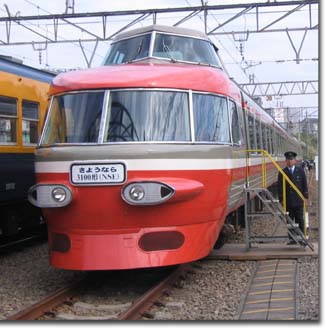 open
house for the Odakyu Railway, which is the Gateway to the Hakone resort
area. It originally ran from Shinjuku to Odewara, but now goes on to
Hakone as well. There is also a line to Kamakura. It is best known for
the train called the Romance Car. This unit looks like a cross between
a 1953 Studebaker and a 1955 Buick, all married in chrome and glass to a
railcar. The defining feature is the driver's compartment, which sits
as a bubble atop the trainset. These trains are being phased out, and
replaced with a
open
house for the Odakyu Railway, which is the Gateway to the Hakone resort
area. It originally ran from Shinjuku to Odewara, but now goes on to
Hakone as well. There is also a line to Kamakura. It is best known for
the train called the Romance Car. This unit looks like a cross between
a 1953 Studebaker and a 1955 Buick, all married in chrome and glass to a
railcar. The defining feature is the driver's compartment, which sits
as a bubble atop the trainset. These trains are being phased out, and
replaced with a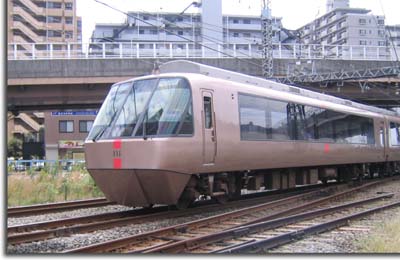 sleeker version that is a pretty conventional looking trainset. No one
really know why it's called the Romance Car. The name just sort of took
hold in 1927, when the line was started. While the official story says
it is because of the double seating, I suspect that it is because the
Hakone resort area was a newlywed destination.
sleeker version that is a pretty conventional looking trainset. No one
really know why it's called the Romance Car. The name just sort of took
hold in 1927, when the line was started. While the official story says
it is because of the double seating, I suspect that it is because the
Hakone resort area was a newlywed destination.
The RailDay was
heavily attended - about 14,000
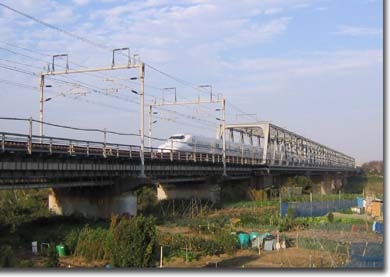 per
day of men, women and children of all ages. We shot what we could, and
then went out to see some train passes over a river. And again, you
just don't realize how big Tokyo is. Even on a Sunday, you get a sense
of the dense population, and the small housing.
per
day of men, women and children of all ages. We shot what we could, and
then went out to see some train passes over a river. And again, you
just don't realize how big Tokyo is. Even on a Sunday, you get a sense
of the dense population, and the small housing.
Everything is just
jammed in here. We also got some Shinkansen passes at high speed. It
is a good thing that the camera will record for 6 seconds on a loop, or
we would never have seen them They are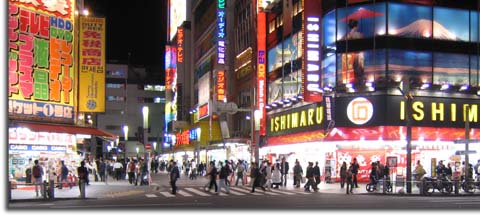 so quiet and so fast, there just isn't time to start recording before
they have come and gone.
so quiet and so fast, there just isn't time to start recording before
they have come and gone.
The day wore on, and we ended by shooting more night footage at the Akihabara section, which is known for it's electronics.
October 16
Today we started
with rush hour, at Shinjuku station. And what a rush hour it was. Lots
of scrambling people. The railroad had put out some little slips of
paper, and our guide said that those
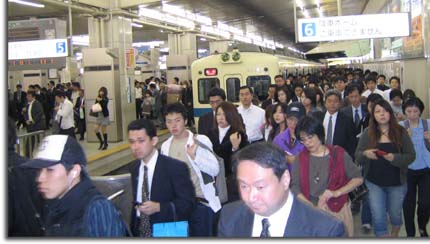 were
excuses. If the train is late, the railroad makes them available to
workers to show at their offices. This is the start of the Odakyu line,
and we shot commuter trains coming and going, as well as the Hakone EXE
Express, and the Romance Car in several different versions. There was
also a photo
were
excuses. If the train is late, the railroad makes them available to
workers to show at their offices. This is the start of the Odakyu line,
and we shot commuter trains coming and going, as well as the Hakone EXE
Express, and the Romance Car in several different versions. There was
also a photo
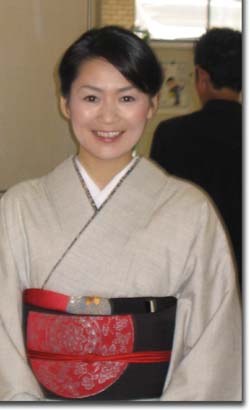 shoot
with TV Tokyo, with a nice looking young model. From there, we left
Tokyo and drove toward Odawara, in the usual heavy traffic. Along the
way we stopped in several locations for train passes of a variety of
Odakyu Railway trains. It is a good thing we have a guide who had this
all pre-scouted. Although the train frequency makes shooting pretty
easy from a time perspective, it takes longer to
shoot
with TV Tokyo, with a nice looking young model. From there, we left
Tokyo and drove toward Odawara, in the usual heavy traffic. Along the
way we stopped in several locations for train passes of a variety of
Odakyu Railway trains. It is a good thing we have a guide who had this
all pre-scouted. Although the train frequency makes shooting pretty
easy from a time perspective, it takes longer to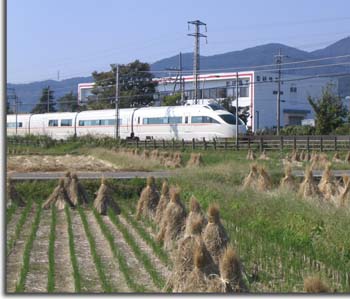 get to the location than to shoot the train. The German team did the
on-board material, and we can supply the external footage. In Odawara,
we found ourselves in mountain foothills, and visited Odawara Castle, a
tourist site. The building, on the original site, is an external
recreation of an important samurai dwelling from the 1400's and is now a
get to the location than to shoot the train. The German team did the
on-board material, and we can supply the external footage. In Odawara,
we found ourselves in mountain foothills, and visited Odawara Castle, a
tourist site. The building, on the original site, is an external
recreation of an important samurai dwelling from the 1400's and is now a
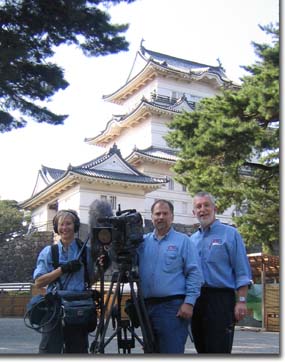 museum.
From there we did more train runbys, and then headed for our hotel,
which was an authentic Japanese Inn.
museum.
From there we did more train runbys, and then headed for our hotel,
which was an authentic Japanese Inn.
You climb into the
mountains to Hakone, battling traffic of course, and take a cable car
down into a valley, where you find an inn on the banks of a rushing
stream. The experience is very impressive, and I'd highly recommend the
Yamatoya Inn if you ever come over. The dinner was great, and the
Japanese baths were very welcoming. Impressions of today are that once
you leave the main city, there really is peace and quiet to be found in
this country. As I type this, I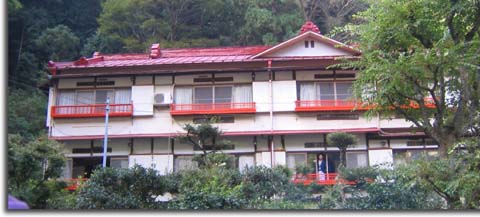 can hear the sound of water over the rocks in the stream, and we are
high enough for the temperature to be nice and cool. And we all look
great in our robes and slippers. This is because we all had the
experience of Japanese bath, which involves plenty of scrubbing and
soaking in hot, hot pools. This is usually followed by a dousing in
cold water, and then dinner with the usual variety of dishes. I don't
think I'd make a habit of rice paper walls, but it was a fun experience.
can hear the sound of water over the rocks in the stream, and we are
high enough for the temperature to be nice and cool. And we all look
great in our robes and slippers. This is because we all had the
experience of Japanese bath, which involves plenty of scrubbing and
soaking in hot, hot pools. This is usually followed by a dousing in
cold water, and then dinner with the usual variety of dishes. I don't
think I'd make a habit of rice paper walls, but it was a fun experience.
October 17 - Hakone Tozen Railway
Sleeping on the
floor all night was actually pretty restful. After a traditional
Japanese breakfast - more rice, dried fish, soup and things I didn't
recognize - we shot a bit of the grounds. This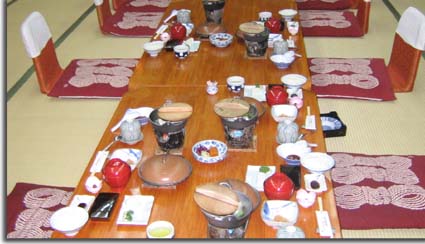 was a great experience, and the baths have to experienced to be
believed. We headed down the steep, winding road to Hakone proper,
which is built in a narrow
was a great experience, and the baths have to experienced to be
believed. We headed down the steep, winding road to Hakone proper,
which is built in a narrow
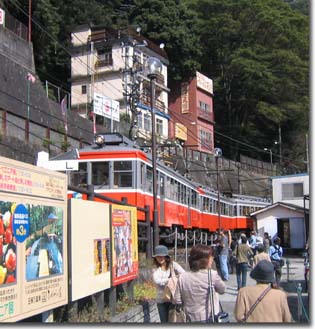 valley.
The roads, garages, houses - everything is right up against the valley
side or into the rock. To give you an idea of steep, we parked on a
street that had a 21% grade! And trucks kept coming up and going down.
This was
valley.
The roads, garages, houses - everything is right up against the valley
side or into the rock. To give you an idea of steep, we parked on a
street that had a 21% grade! And trucks kept coming up and going down.
This was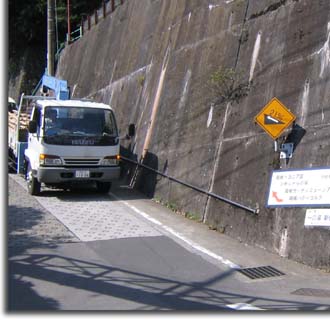 steeper than most, but not by much. And things were very narrow. The
Hakone Tozen Railway is actually a three line experience (well, you can
buy the Free Pass, and get a Pirate ship ride, but more on that later).
The first line, the traction part (or conventional electric railway) was
opened in 1887 from Odawara station.
steeper than most, but not by much. And things were very narrow. The
Hakone Tozen Railway is actually a three line experience (well, you can
buy the Free Pass, and get a Pirate ship ride, but more on that later).
The first line, the traction part (or conventional electric railway) was
opened in 1887 from Odawara station.
The line has steep
grades of 8% (American
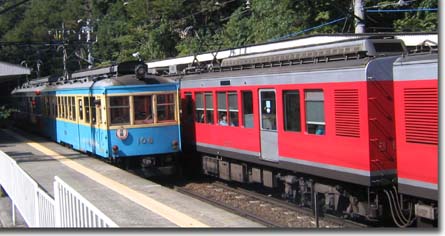 lines
run into trouble between 2 & 3%) and uses water dripped on the rails to
increase adhesion. I don't understand how that works. The line is
mostly hidden, running through a green tunnel, but we did the best we
could with exteriors. Those were our responsibility, as the German crew
did the on-board material. There is a mixture of old and new cars. The
second part is a funicular, or cable car from Gola to Sounzan, where you
pick up a ropeway or cable car like we experienced in Australia. This
makes a
lines
run into trouble between 2 & 3%) and uses water dripped on the rails to
increase adhesion. I don't understand how that works. The line is
mostly hidden, running through a green tunnel, but we did the best we
could with exteriors. Those were our responsibility, as the German crew
did the on-board material. There is a mixture of old and new cars. The
second part is a funicular, or cable car from Gola to Sounzan, where you
pick up a ropeway or cable car like we experienced in Australia. This
makes a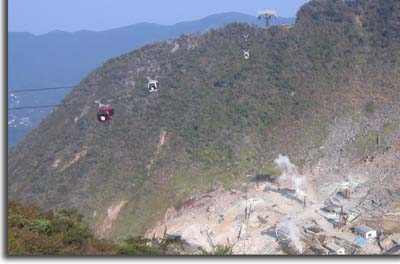 sweeping run up the mountain to Owakudani, crossing forests and steaming
sulphur vents. The line will eventually be extended to Togendai, on the
shore of Lake Ashi. We could barely see Mt. Fuji, and were going to do
more, but it started to cloud up. Nikki, out guide, assures us of good
weather tomorrow, but for the moment, it looks pretty grim. We are all
tired and happy to be in a hotel.
sweeping run up the mountain to Owakudani, crossing forests and steaming
sulphur vents. The line will eventually be extended to Togendai, on the
shore of Lake Ashi. We could barely see Mt. Fuji, and were going to do
more, but it started to cloud up. Nikki, out guide, assures us of good
weather tomorrow, but for the moment, it looks pretty grim. We are all
tired and happy to be in a hotel.
October 18
The day stated
early for John, as he got up at dawn to shoot Mt. Fuji from the roof of
the hotel. Unfortunately, the mountain is as allusive as most
mountains, and only shows in a haze. The Japanese say that the mountain
is shy. There is no snow on it, as
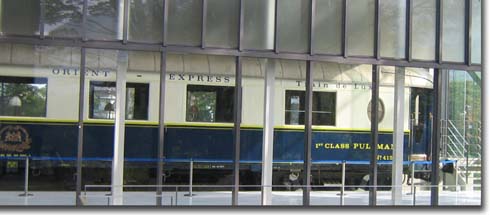 it
is still to early in the season, and the recent snows have melted. The
first official stop of the day was the Lalique Museum in Hakone. Why do
this as a part of a railroad series?
it
is still to early in the season, and the recent snows have melted. The
first official stop of the day was the Lalique Museum in Hakone. Why do
this as a part of a railroad series?
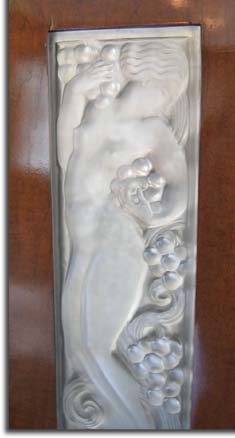 Hey, it was cultural and beautiful, with wonderful displays of glass
made by Rene' Lalique. The grounds were like golf course greens, and
the gardens were a work of art. They have one of the original Orient
Express cars, which had interior panels of Lalique glass. It was a
beautiful museum, and well worth a visit. From there, we worked on
exterior scenic material of the Lake Ashi area around Hakone. The lake
is the largest of five lakes, and
Hey, it was cultural and beautiful, with wonderful displays of glass
made by Rene' Lalique. The grounds were like golf course greens, and
the gardens were a work of art. They have one of the original Orient
Express cars, which had interior panels of Lalique glass. It was a
beautiful museum, and well worth a visit. From there, we worked on
exterior scenic material of the Lake Ashi area around Hakone. The lake
is the largest of five lakes, and
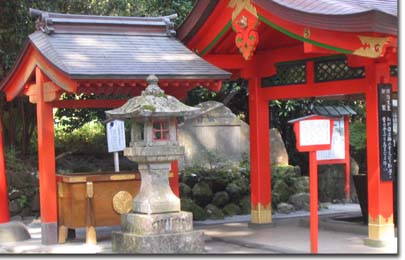 surrounded
by scenery, resorts, vacation homes, and corporate retreats. It is all
done very tastefully, and everything blends into the overall beauty of
the scenery. On the other hand, the tourist boats on the lake consist
of a replica of the Mississippi sternwheeler, pirate galleons, and a
surrounded
by scenery, resorts, vacation homes, and corporate retreats. It is all
done very tastefully, and everything blends into the overall beauty of
the scenery. On the other hand, the tourist boats on the lake consist
of a replica of the Mississippi sternwheeler, pirate galleons, and a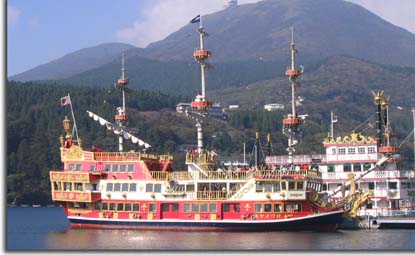 modern lake cruise ship. It all seems a bit bizarre to me, but seems to
work for everyone here. We stopped at the Hakone shrine, and walked a
bit of the original Tokaido (road) which wound through the mountains in
early times. In fact, we stopped at a toll collection gate, which was
where travelers had
modern lake cruise ship. It all seems a bit bizarre to me, but seems to
work for everyone here. We stopped at the Hakone shrine, and walked a
bit of the original Tokaido (road) which wound through the mountains in
early times. In fact, we stopped at a toll collection gate, which was
where travelers had
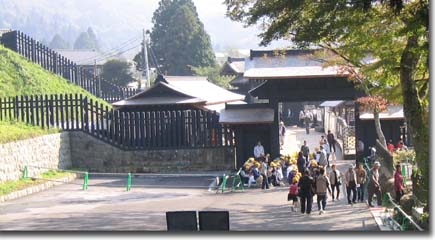 to
pay to pass through the land. Needless to say, small towns grew up on
those sites. Lake Ashi and the Hakone area are really worth a trip, and
quite lovely.
to
pay to pass through the land. Needless to say, small towns grew up on
those sites. Lake Ashi and the Hakone area are really worth a trip, and
quite lovely.
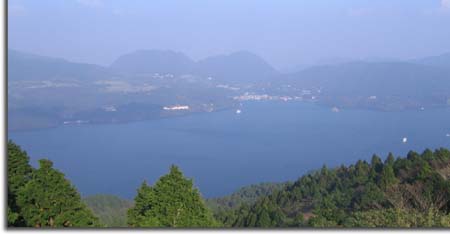
The views from Hakone Pass (1,070 meters) is breathtaking. I (foolish me) did not realize that this mountainous area existed. Hotels are plentiful, and the dining is superb. Check it out. Tonight, we find ourselves back in Odawara, getting ready to head for Kyoto tomorrow.
October 19 - Umekoji Steam Museum & Kyoto
I could not sleep
last night. I don't know what the problem was, but the rice husk,
hard-as-a-rock pillows may have been the cause. We were all up early
and off to the station to catch the #361 Shinkansen to Kyoto at 0710.
And of course, to watch the trains blow through the station. The
Shinkansen's go through at 250 km/hr, with no speed reduction. It is
pretty amazing to just stand there and watch then zip past. It was
always quite a fire drill to get all our luggage on the train within the
1-2 minute stop, but we managed, and settled into our first class seats
to watch the passing scenery. This was my first Shinkansen ride, and it
is smooth as glass. The only difficult thing is trying to fix your
vision on the scenery as you pass at such high speed. And the rather
abrupt passing of other Shinkansen trains going in the opposite
direction. That takes about 5 seconds, and you feel the trains briefly
sucked toward the other. Even in the station, you can feel the rush of
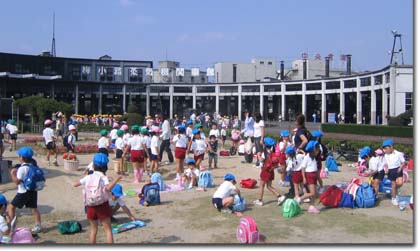 displaced
air as the trains speed through. We arrived at the hotel, only to find
that our rooms were not ready. So we headed out to the Umekoji Steam
Museum, which is our next story. The Museum is a PR site dedicated to
steam preservation, and is owned by Japan Rail West. The Deputy
Director, Mr. Ono, was extremely pleasant, and really spent a great deal
of time with us. His English was quite good, and he said he learned it
from watching BBC World, and other English services. The museum has
some very nice displays contained within the original Nijo Station,
which was moved to the site in a preservation effort.
displaced
air as the trains speed through. We arrived at the hotel, only to find
that our rooms were not ready. So we headed out to the Umekoji Steam
Museum, which is our next story. The Museum is a PR site dedicated to
steam preservation, and is owned by Japan Rail West. The Deputy
Director, Mr. Ono, was extremely pleasant, and really spent a great deal
of time with us. His English was quite good, and he said he learned it
from watching BBC World, and other English services. The museum has
some very nice displays contained within the original Nijo Station,
which was moved to the site in a preservation effort.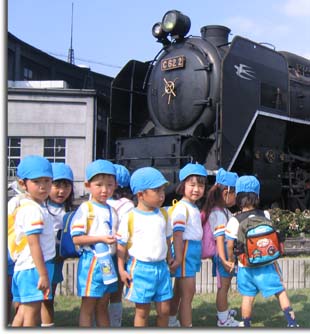 They have a twenty stall roundhouse, and one operating steam loco that
offers a one kilometer ride. There were groups of grade school children
there, drawing the trains and riding. The classes are all identified by
different hats - pink, blue, green, etc. And all sort of stayed
together. The museum laid on two extra runs for us, and we were able to
finish the whole thing in a single day. The engine was a freight loco,
and is rather unusual in that regard.
They have a twenty stall roundhouse, and one operating steam loco that
offers a one kilometer ride. There were groups of grade school children
there, drawing the trains and riding. The classes are all identified by
different hats - pink, blue, green, etc. And all sort of stayed
together. The museum laid on two extra runs for us, and we were able to
finish the whole thing in a single day. The engine was a freight loco,
and is rather unusual in that regard.
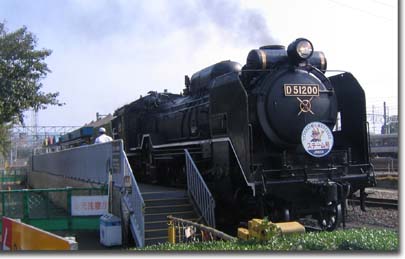
In fact, we have seen only about two freight trains - the vast majority are passenger, quite the reverse of the United States. We are now ready to go to yet another Japanese restaurant. The only thing that I am hopeful of is that one of the German team does not like fish, so perhaps there will be some variety. Tomorrow, we can explore Kyoto (which is a tourist city) for scenery shots.
October 20
Today dawned with
overcast skies. The whole day threatened rain, and was around 23
degrees (C) and muggy. So we were not able to get much
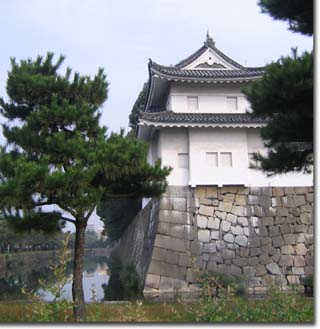 color.
We started by visiting Nijo Castle, but truthfully, all we could get was
the moat and walls. We were unable to get permission to shoot inside,
so off we went to the Toji Temple, with it's large pagoda spires.
Traffic was heavy, and it took about ten minutes just to get around the
block. From there, we hustled back to the Umekoji Steam Museum to see
the train pass from a park. This was really pretty neat, as there were
a lot of little children with butterfly nets, out collecting things.
Then it was off to the Kiyomizu Shrine, which is a combination Buddhist
and Shinto Temple. It was a massive complex, with pegged construction
and a dominating view of Kyoto.
color.
We started by visiting Nijo Castle, but truthfully, all we could get was
the moat and walls. We were unable to get permission to shoot inside,
so off we went to the Toji Temple, with it's large pagoda spires.
Traffic was heavy, and it took about ten minutes just to get around the
block. From there, we hustled back to the Umekoji Steam Museum to see
the train pass from a park. This was really pretty neat, as there were
a lot of little children with butterfly nets, out collecting things.
Then it was off to the Kiyomizu Shrine, which is a combination Buddhist
and Shinto Temple. It was a massive complex, with pegged construction
and a dominating view of Kyoto.
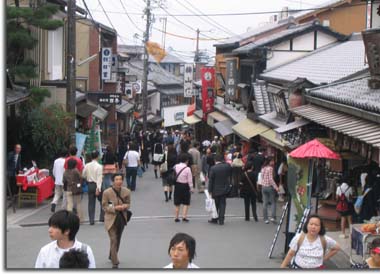
The narrow, winding streets leading up to the temple were full of tourist shops, and I confess that I did succumb on an item or two.
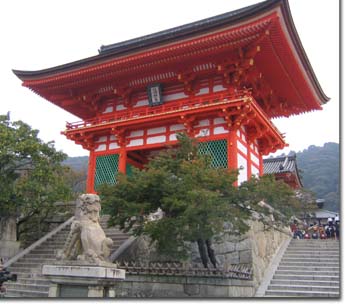
From there we went
to the Heian Shrine, which is really a copy of the Forbidden City in
Beijing, but has a wonderful garden. It is hard to believe that this
arboreal solitude is right in downtown Kyoto. And from there we went to
the Gion District to try to catch the elusive Geishas and Mikos as they
started their work for the evening. It was a little like trying to
shoot wild animals as the ladies were elusive. The concept in the West
is that Geishas are prostitutes, but that is not the case. They are
evening entertainment companions, who can make conversation, sing, play
an instrument,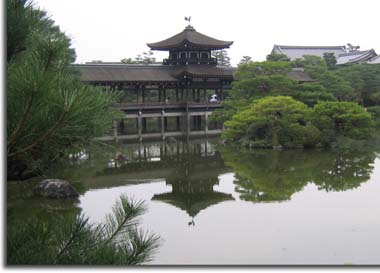 dance, and generally add life to an evening. A Miko is an apprentice,
who starts around the age of sixteen, and learns the rituals and work of
the full geisha. When a Miko obtains a sponsor, then she becomes a
Geisha. The sponsor has a kimono made, pays for the upkeep, and in
return, the Geisha is always available for entertainment (business
parties, etc.). It was a long day. Dinner was a Korean restaurant,
which was quite tasty. Tomorrow we shoot more scenery, while our German
companions are off with a Marklin fan.
dance, and generally add life to an evening. A Miko is an apprentice,
who starts around the age of sixteen, and learns the rituals and work of
the full geisha. When a Miko obtains a sponsor, then she becomes a
Geisha. The sponsor has a kimono made, pays for the upkeep, and in
return, the Geisha is always available for entertainment (business
parties, etc.). It was a long day. Dinner was a Korean restaurant,
which was quite tasty. Tomorrow we shoot more scenery, while our German
companions are off with a Marklin fan.
October 21
Our friends were
looking a tad dreary this morning. Seems they stayed out with their
host until 4AM. No jogging for them today. We played a bit of tourist
on this bright sunny day. It would have been so much
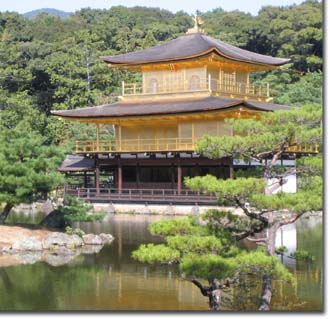 better
to have this weather yesterday. We went to the Rokuon-Ji (Golden
Temple). The grounds were immaculate, and the temple was stunning in
the bright sunlight. But the German team shot this yesterday, and said
that it was much better in an overcast situation. The temple was also a
cattle call, as every tour group and school group was there. We drove
through the old weaving district, and stopped to see an open house,
which was about a 100 years old. It was part of a preservation effort,
and we were invited to see the living quarters.
better
to have this weather yesterday. We went to the Rokuon-Ji (Golden
Temple). The grounds were immaculate, and the temple was stunning in
the bright sunlight. But the German team shot this yesterday, and said
that it was much better in an overcast situation. The temple was also a
cattle call, as every tour group and school group was there. We drove
through the old weaving district, and stopped to see an open house,
which was about a 100 years old. It was part of a preservation effort,
and we were invited to see the living quarters.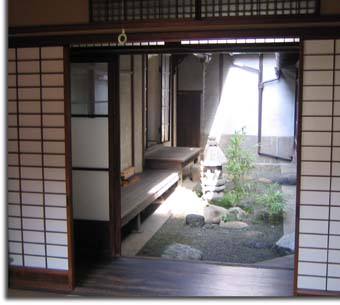 The house was a lot bigger than it looked, with an atrium garden and a
back yard garden. Lawn mowers would not sell here, except to golf
courses. The original owner was there, and told us about
The house was a lot bigger than it looked, with an atrium garden and a
back yard garden. Lawn mowers would not sell here, except to golf
courses. The original owner was there, and told us about
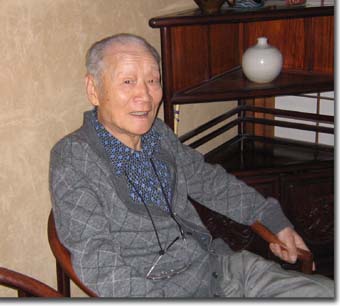 some
of his experiences weaving and running his business. Just a word on
Japan's cleanliness. It is extremely clean. There are no plastic bags
blowing around, no cigarette butts, no fast food wrappers. People favor
others before themselves, which is evident in driving habits, walking,
and general life. It is something which the west - particularly
Americans - could use as a lesson. Perhaps the Japanese are too much
one way, but we could certainly use a touch of it in our rude society.
There are no mobile phone conversations in restaurants, on the trains,
or in stores. If a call is made, it is done in a quiet place, and the
voices are kept down. Texting seems to be much more in vogue than the
voice call. There are no boom cars, and no loud mufflers. It was quite
refreshing to this writer. We moved on the Imperial Palace. Only
foreign passport holders are allowed in. Unfortunately, we were not one
of the selected few because we just didn't get reservations far enough
in advance. After a delicious lunch in a little hole in the wall
restaurant, we hopped on the Shinkansen back toward Tokyo, getting into
Nagoya which is where we are staying for three days. Dinner was at -
believe it or not - Denny's. It was far and away better than the
states. And they serve Kirin, Japanese beer.
some
of his experiences weaving and running his business. Just a word on
Japan's cleanliness. It is extremely clean. There are no plastic bags
blowing around, no cigarette butts, no fast food wrappers. People favor
others before themselves, which is evident in driving habits, walking,
and general life. It is something which the west - particularly
Americans - could use as a lesson. Perhaps the Japanese are too much
one way, but we could certainly use a touch of it in our rude society.
There are no mobile phone conversations in restaurants, on the trains,
or in stores. If a call is made, it is done in a quiet place, and the
voices are kept down. Texting seems to be much more in vogue than the
voice call. There are no boom cars, and no loud mufflers. It was quite
refreshing to this writer. We moved on the Imperial Palace. Only
foreign passport holders are allowed in. Unfortunately, we were not one
of the selected few because we just didn't get reservations far enough
in advance. After a delicious lunch in a little hole in the wall
restaurant, we hopped on the Shinkansen back toward Tokyo, getting into
Nagoya which is where we are staying for three days. Dinner was at -
believe it or not - Denny's. It was far and away better than the
states. And they serve Kirin, Japanese beer.
October 22 - Meitetsu Panorama Car
Today was spent
chasing trains. But then, that's what we are here for.
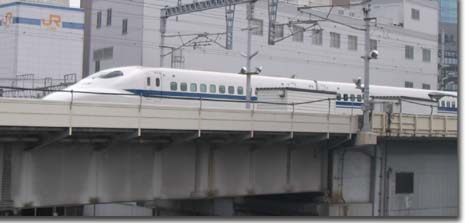 The
day started sunny, but deteriorated to grey and drizzle. We started
with a nice static location of passing Skinkansen's entering and leaving
Nagoya Station. And from there, progressed to the Meitetsu Line, which
runs out to the Central Japan Airport. The interesting thing about this
110 year old line is the Panorama Cars, of which there are two models.
These are similar to the Odakyu Romance cars, in that
The
day started sunny, but deteriorated to grey and drizzle. We started
with a nice static location of passing Skinkansen's entering and leaving
Nagoya Station. And from there, progressed to the Meitetsu Line, which
runs out to the Central Japan Airport. The interesting thing about this
110 year old line is the Panorama Cars, of which there are two models.
These are similar to the Odakyu Romance cars, in that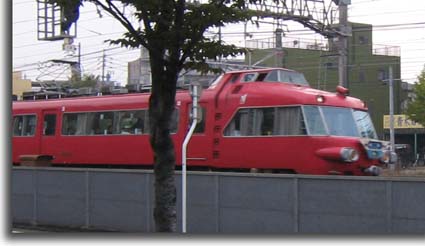 the driver either sits on top of the engine (the 7000 model) or under
the passengers (the 1000 model). This gives the front passengers a
wide, unobstructed view of the track ahead and passing scenery. The
only problem for me is that the smooth motion and white noise just
instantly puts me to sleep. These are all being replaced with the
express MuSky trains, which look a bit like a beetle. I think the charm
is in the old units, but progress moves on. We certainly didn't have to
wait for trains to pass. And we saw some freight,
the driver either sits on top of the engine (the 7000 model) or under
the passengers (the 1000 model). This gives the front passengers a
wide, unobstructed view of the track ahead and passing scenery. The
only problem for me is that the smooth motion and white noise just
instantly puts me to sleep. These are all being replaced with the
express MuSky trains, which look a bit like a beetle. I think the charm
is in the old units, but progress moves on. We certainly didn't have to
wait for trains to pass. And we saw some freight,
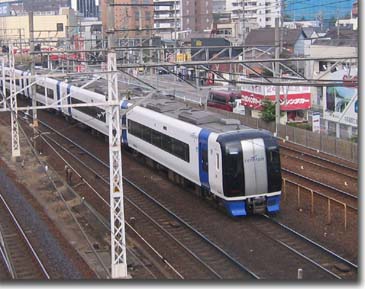 moving
quite fast, as do all the trains here. Road traffic was extremely
heavy, and I am amazed at the number of people who are out and about on
a Sunday night. Nikki says it is because the houses are so small, no
one wants to stay home! Nagoya is the site of a lot of heavy industry,
notably Mitsubishi, and was heavily bombed during WW2. The roads are
all very wide, and according to our driver, were made that way to serve
as airplane runways during the war. But the place has been rebuilt, and
is as busy as can be, with a huge trade and convention center. This
thing puts Chicago's trade center to shame. We're talking big. But
traffic was so heavy that I just couldn't get a shot of it.
moving
quite fast, as do all the trains here. Road traffic was extremely
heavy, and I am amazed at the number of people who are out and about on
a Sunday night. Nikki says it is because the houses are so small, no
one wants to stay home! Nagoya is the site of a lot of heavy industry,
notably Mitsubishi, and was heavily bombed during WW2. The roads are
all very wide, and according to our driver, were made that way to serve
as airplane runways during the war. But the place has been rebuilt, and
is as busy as can be, with a huge trade and convention center. This
thing puts Chicago's trade center to shame. We're talking big. But
traffic was so heavy that I just couldn't get a shot of it.
October 23 - Meiji Mura Museum
Today dawned grey
and overcast. And it pretty much remained that way until about 4 PM,
when it started to rain. We spent the day at the Meiji Mura
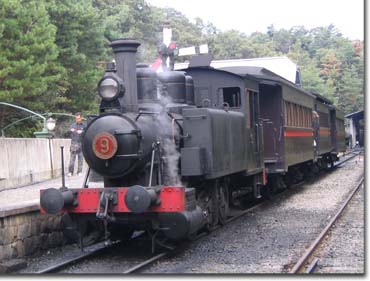 Museum,
which consists of historic structures from around Japan. They have all
been gathered in one place. So you get to see the first iron railway
bridge, Shinagawa Lighthouse, a teahouse, the home of writer Rohan Koda,
a police call box, factories, the first Kyoto streetcars, and of course,
steam trains. Things were really kind of grey and lifeless, but we did
the best we could.
Museum,
which consists of historic structures from around Japan. They have all
been gathered in one place. So you get to see the first iron railway
bridge, Shinagawa Lighthouse, a teahouse, the home of writer Rohan Koda,
a police call box, factories, the first Kyoto streetcars, and of course,
steam trains. Things were really kind of grey and lifeless, but we did
the best we could.
There was an
awesome bright spot in the day - the Imperial Hotel, which was designed
by Frank Lloyd Wright, and was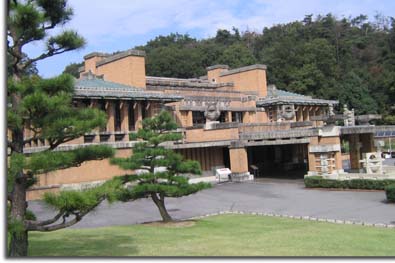 famous not only for it's look, but for the foundation design. It
survived a very strong earthquake back in the 20's or 30's, and has been
used as an example of a floating foundation. I really thought that it
was long gone, but there it was, dismantled, and rebuilt section by
section. I never
famous not only for it's look, but for the foundation design. It
survived a very strong earthquake back in the 20's or 30's, and has been
used as an example of a floating foundation. I really thought that it
was long gone, but there it was, dismantled, and rebuilt section by
section. I never
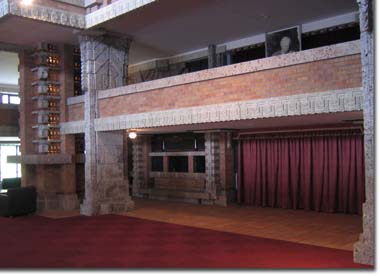 thought
I'd get to see it. It's really a magnificent piece of work, both
externally and internally. All the displays are integrated into the
landscape, and I would suggest good walking shoes if you visit. The
museum is on multiple levels, but it really is an interesting place, and
well worth the hour drive from Nagoya. There is just so much here that
deals with the architectural heritage of the Meiji Era, which was when
Japan was trying to Westernize as quickly as possible. So old machinery
is side by side with traditional Japanese
thought
I'd get to see it. It's really a magnificent piece of work, both
externally and internally. All the displays are integrated into the
landscape, and I would suggest good walking shoes if you visit. The
museum is on multiple levels, but it really is an interesting place, and
well worth the hour drive from Nagoya. There is just so much here that
deals with the architectural heritage of the Meiji Era, which was when
Japan was trying to Westernize as quickly as possible. So old machinery
is side by side with traditional Japanese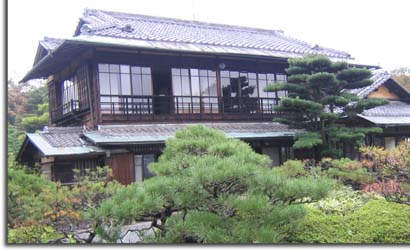 houses. Fortunately, the rain held off until we were done shooting. On
the way back, I stopped at a Kinko's/FedEx store to ship home a box of
tape. What a hassle that was. For the tape you are supposed to list
the contents and the material on each one. Ha!. And I also shipped
home some shirts and a jacket of John's that was just taking up space.
I was supposed to list the origin of the shirts and jacket, the cloth
makeup, and the address of the manufacturer. Again, Ha! I hope it all
arrives. (It did, thank you FedEx.) At least I have tracking numbers.
Damn US government regulations (or so say the Japanese).
houses. Fortunately, the rain held off until we were done shooting. On
the way back, I stopped at a Kinko's/FedEx store to ship home a box of
tape. What a hassle that was. For the tape you are supposed to list
the contents and the material on each one. Ha!. And I also shipped
home some shirts and a jacket of John's that was just taking up space.
I was supposed to list the origin of the shirts and jacket, the cloth
makeup, and the address of the manufacturer. Again, Ha! I hope it all
arrives. (It did, thank you FedEx.) At least I have tracking numbers.
Damn US government regulations (or so say the Japanese).
October 24 - Oigawa Tetsudo Steam Railway
I found out why I
haven't seen anyone talking on their mobiles while driving. It's
illegal. What a concept. Today we all piled in the van, making it look
a bit like a clown car, and headed of to a national park
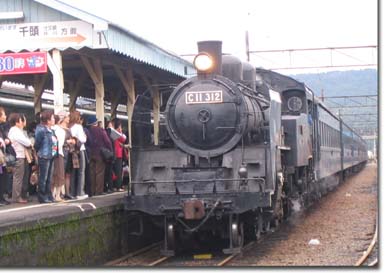 area.
There, in the town of Shimada, we found the Oigawa Tetsudo Railway
Company. They run a 70 kilometer stretch of line through the mountains
in central Japan. The first 40 Km has two 2-6-2 steam tank locos, and
the remainder of the line is covered by a combination traction and cog
railway. This is a steep mountain area, and the roads are often one
lane, curvy, and slow. The Oigawa River winds through the area, and is
quite broad, which makes for some spectacular bridges. So there are
tunnels, river valley, wide
area.
There, in the town of Shimada, we found the Oigawa Tetsudo Railway
Company. They run a 70 kilometer stretch of line through the mountains
in central Japan. The first 40 Km has two 2-6-2 steam tank locos, and
the remainder of the line is covered by a combination traction and cog
railway. This is a steep mountain area, and the roads are often one
lane, curvy, and slow. The Oigawa River winds through the area, and is
quite broad, which makes for some spectacular bridges. So there are
tunnels, river valley, wide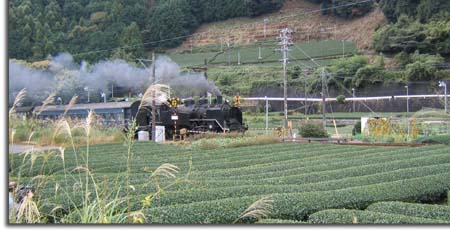 crossing, and lots of tea bushes. By driving, you can barely keep up
with the train, and with only two trips a day, it makes for difficult
times. And to add to the problems, today it rained. It was a hard,
driving, monsoon rain, that just kept up all day long. So we got some
footage, but how usable it will be is debatable. It is a good thing
that there are two crews on this, as you could easily spend a week to
cover both lines. We have two and a half days. The weather forecast is
for party sunny skies, so hopefully, we can get things done. Did I
mention vending machines? You can get pretty much anything in a vending
machine - including beer. And restaurant ordering is very neat. T
crossing, and lots of tea bushes. By driving, you can barely keep up
with the train, and with only two trips a day, it makes for difficult
times. And to add to the problems, today it rained. It was a hard,
driving, monsoon rain, that just kept up all day long. So we got some
footage, but how usable it will be is debatable. It is a good thing
that there are two crews on this, as you could easily spend a week to
cover both lines. We have two and a half days. The weather forecast is
for party sunny skies, so hopefully, we can get things done. Did I
mention vending machines? You can get pretty much anything in a vending
machine - including beer. And restaurant ordering is very neat. T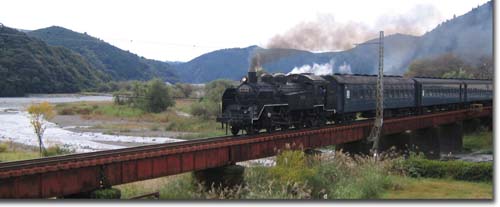 he
server appears with an electronic pad. They punch in your selections,
and the order is transmitted directly to the kitchen or the bar. Very
nifty, and saves time for both the server and the customer. It also
allows a faster turnover on the tables. And speaking of the tables,
there is a call button to summon the server. No need to flag down the
attendant. Just push the button. Our German friends said that they
have seen this in Europe, but I haven't seen it yet in the US. Anyway,
dinner was the usual Japanese assortment of stuff, some raw, some
cooked, but all good. Tomorrow we go to work in better weather - I
hope.
he
server appears with an electronic pad. They punch in your selections,
and the order is transmitted directly to the kitchen or the bar. Very
nifty, and saves time for both the server and the customer. It also
allows a faster turnover on the tables. And speaking of the tables,
there is a call button to summon the server. No need to flag down the
attendant. Just push the button. Our German friends said that they
have seen this in Europe, but I haven't seen it yet in the US. Anyway,
dinner was the usual Japanese assortment of stuff, some raw, some
cooked, but all good. Tomorrow we go to work in better weather - I
hope.
October 25
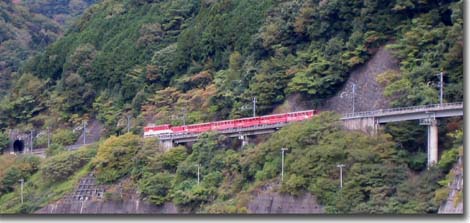 All
I can say about today is "wow!" Well, OK, I can say more and will.
This morning, the weather was considerably improved. The German
crew went off to shoot the locomotive firing, and the interviews, and we
headed up the Oigawa River to Senzu, to catch the first traction/cog
train of the day. This goes through 61 tunnels and over 55 bridges
to reach the town of Igawa in the Minami Alps area. The highest
peak is at 3,192 meters, and there were a lot of hikers on the train.
John and Gail rode, and I looked for places to shoot from the road.
Truthfully, there weren't
All
I can say about today is "wow!" Well, OK, I can say more and will.
This morning, the weather was considerably improved. The German
crew went off to shoot the locomotive firing, and the interviews, and we
headed up the Oigawa River to Senzu, to catch the first traction/cog
train of the day. This goes through 61 tunnels and over 55 bridges
to reach the town of Igawa in the Minami Alps area. The highest
peak is at 3,192 meters, and there were a lot of hikers on the train.
John and Gail rode, and I looked for places to shoot from the road.
Truthfully, there weren't
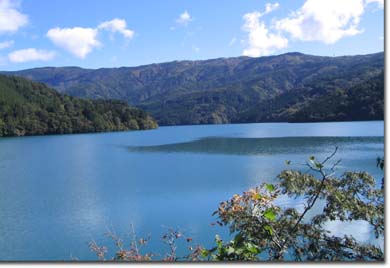 many,
but it was quite a ride by car.
many,
but it was quite a ride by car.
The roads are generally one lane, which
are shared with cars, dump trucks and smaller buses. They hug the
mountain side, winding and twisting up and down the sides. But the
views are breathtaking. There are 23 hydro dams along the way,
making for some serene lakes and endless greenery of steep forested
hillsides. We thought we would be delayed a bit due to some rock
slides, but they were all cleaned up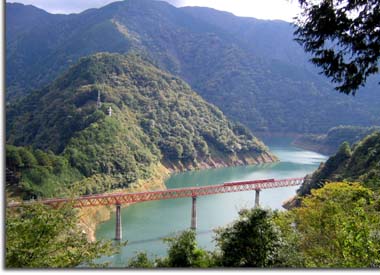 by the time we arrived. The railroad itself is a small, diesel
powered consist, which slowly crawls up the mountains. Between two
stations, the grade is so steep that an electric cog engine is coupled,
and pulls or pushes the train up the grade. The bridges are long
and colorful, with the train dwarfed by the surrounding scenery.
by the time we arrived. The railroad itself is a small, diesel
powered consist, which slowly crawls up the mountains. Between two
stations, the grade is so steep that an electric cog engine is coupled,
and pulls or pushes the train up the grade. The bridges are long
and colorful, with the train dwarfed by the surrounding scenery.
And that is what we did - chased the
train up and down the mountain. It started to cloud up late in the
day, so we went back to Senzu, and shot some material in the maintenance
yard of the engines being scrubbed down for the next day. I think
the last time I saw a US loco washed it was done either by
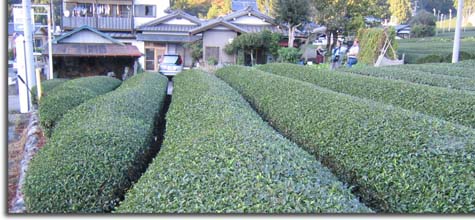 the
rain, or by a machine! We passed many tea fields along the way.
The round topped bushes are trimmed with a two person machine to get the
curvature right, and allow new leaves to form. The area is a "must
visit" for the scenery, the solitude, and the rural atmosphere.
Yes, Virginia, there are rural areas, and this is one of them.
Don't miss it.
the
rain, or by a machine! We passed many tea fields along the way.
The round topped bushes are trimmed with a two person machine to get the
curvature right, and allow new leaves to form. The area is a "must
visit" for the scenery, the solitude, and the rural atmosphere.
Yes, Virginia, there are rural areas, and this is one of them.
Don't miss it.
October 26
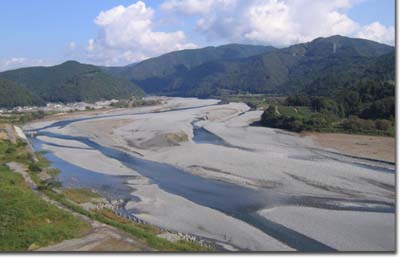 We
started the day with an interview with the designer of the Meitetsu
Panorama car (see Oct 22-23). He is active in steam preservation here
on the Oigawa Railway, and a spry 81 year old. His idea for the cars
came from the Golden Chariot streetcars which were tiered open trolleys
used in Montreal around 1906. He was quite talkative! From there it
was back up to Senzu, shooting some scenic vistas of the Oigawa River
Valley. This must have been an awesome river before they installed the
23 dams. We did some minor steam train chasing and then chased the cog
line again. This is very pretty country. I have to tell you folks,
that I've been on some pretty train rides. But this one is one of the
best. The scenery is stunning on
We
started the day with an interview with the designer of the Meitetsu
Panorama car (see Oct 22-23). He is active in steam preservation here
on the Oigawa Railway, and a spry 81 year old. His idea for the cars
came from the Golden Chariot streetcars which were tiered open trolleys
used in Montreal around 1906. He was quite talkative! From there it
was back up to Senzu, shooting some scenic vistas of the Oigawa River
Valley. This must have been an awesome river before they installed the
23 dams. We did some minor steam train chasing and then chased the cog
line again. This is very pretty country. I have to tell you folks,
that I've been on some pretty train rides. But this one is one of the
best. The scenery is stunning on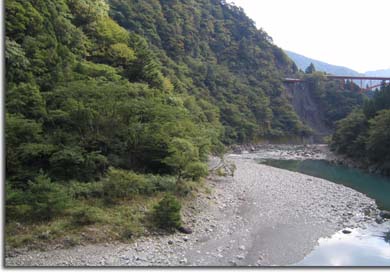 the run from Senzu to Igawa. There are deep canyons, soaring bridges,
tunnels, forest, streams, and rocks. It is spectacular. Unfortunately,
the still camera can't capture the scope of everything. We shot the
double bridge and temple again from a different angle, and stopped at
the Fureai no
Izumi bath house to try to
get a shot of bathers waving at the train. Unfortunately, the sun was
directly in our face, the the bathers were, of course, nude. It doesn't
bother us, but why risk offending the quixotic sensibilities of the
American viewer? They should really get out more
the run from Senzu to Igawa. There are deep canyons, soaring bridges,
tunnels, forest, streams, and rocks. It is spectacular. Unfortunately,
the still camera can't capture the scope of everything. We shot the
double bridge and temple again from a different angle, and stopped at
the Fureai no
Izumi bath house to try to
get a shot of bathers waving at the train. Unfortunately, the sun was
directly in our face, the the bathers were, of course, nude. It doesn't
bother us, but why risk offending the quixotic sensibilities of the
American viewer? They should really get out more
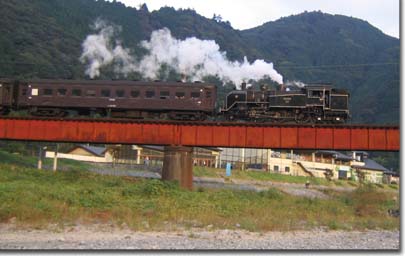 and
watch late night Japanese TV! But that is another story. So we shot
the train from the other side, which made for a great side-lighted
picture. And after shooting more tea fields, we were done. We ran
through the Shimada rush hour, said our good-byes to the great people at
the railway, and headed for Kanagawa, which is just down the road, and
close to the railway station. Tomorrow is a travel day. Yea, right.
We shall see. A couple of additional points. Japanese children go to
school all year, with the exception of about a month in August, and a
couple of weeks off in December and March. No wonder they beat the
pants of the US educational system.
and
watch late night Japanese TV! But that is another story. So we shot
the train from the other side, which made for a great side-lighted
picture. And after shooting more tea fields, we were done. We ran
through the Shimada rush hour, said our good-byes to the great people at
the railway, and headed for Kanagawa, which is just down the road, and
close to the railway station. Tomorrow is a travel day. Yea, right.
We shall see. A couple of additional points. Japanese children go to
school all year, with the exception of about a month in August, and a
couple of weeks off in December and March. No wonder they beat the
pants of the US educational system.
October 27 - Yamaguchi-Go Steam Railroad
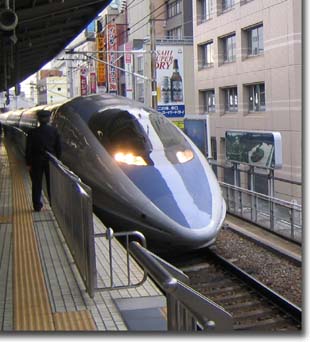 Today,
we started off with a four hour Shinkansen ride down to Yamaguchi. In
fact, as I proof this and type anew, we are on the train, running at 200
km/hr to the southwest. These guys really do fly along; even through
the stations. We arrived in the southwestern part of Japan, and Shin
Yamaguchi, which is our final destination. Here, we will find the C571
steam train, which is a restored engine running a trip on Saturday and
Sunday to Tsuwano and back. It was a bit past noon, so rather than
waste a lot of time trying to eat
Today,
we started off with a four hour Shinkansen ride down to Yamaguchi. In
fact, as I proof this and type anew, we are on the train, running at 200
km/hr to the southwest. These guys really do fly along; even through
the stations. We arrived in the southwestern part of Japan, and Shin
Yamaguchi, which is our final destination. Here, we will find the C571
steam train, which is a restored engine running a trip on Saturday and
Sunday to Tsuwano and back. It was a bit past noon, so rather than
waste a lot of time trying to eat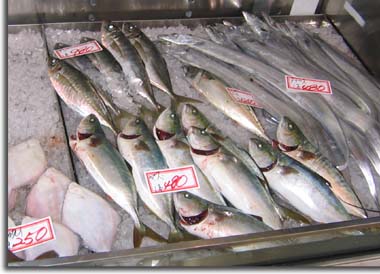 lunch someplace, we just dived into a local grocery store. You will
note the eels in the case. I haven't tried them yet, but I do know that
the tuna rolls are
lunch someplace, we just dived into a local grocery store. You will
note the eels in the case. I haven't tried them yet, but I do know that
the tuna rolls are
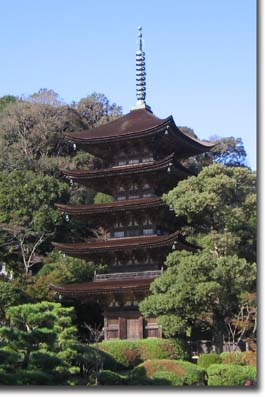 delicious.
Yamaguchi is best know for it's pagodas, and this one is a
representative from 1442. From there we drove up the rail line to
Tsuwano, picking spots for tomorrow. This is going to be tough as the
road is slow, the train moves more directly, and we only have one train
each day. We did pick up some beauty shots along the way. I
particularly like the way the Japanese pines are often etched
delicious.
Yamaguchi is best know for it's pagodas, and this one is a
representative from 1442. From there we drove up the rail line to
Tsuwano, picking spots for tomorrow. This is going to be tough as the
road is slow, the train moves more directly, and we only have one train
each day. We did pick up some beauty shots along the way. I
particularly like the way the Japanese pines are often etched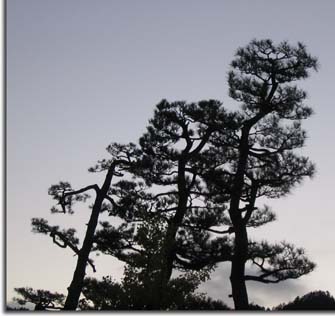 against the sky. Dinner was in a Mexican restaurant, which was sort of
surreal. And then we blew $20 playing Pachinko. It is addictive, with
the lights and sounds, but we are all pretty clueless as to the point.
It was nice to hear those gambling machine sounds and clink of money in
trays, which is an aural experience that seems to be gone from Vegas.
against the sky. Dinner was in a Mexican restaurant, which was sort of
surreal. And then we blew $20 playing Pachinko. It is addictive, with
the lights and sounds, but we are all pretty clueless as to the point.
It was nice to hear those gambling machine sounds and clink of money in
trays, which is an aural experience that seems to be gone from Vegas.
October 28
Today
was actually a much better day than I anticipated. We arrived at the
yard to find a whole semi-circle of JR West rail diesel cars awaiting
us. But no steam engine. Finally we discovered it tucked into a
special
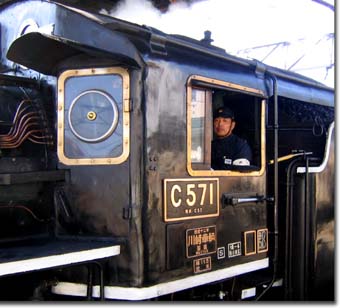 shed
in the end of the yard, guarded by it's crew. First we had an interview
with the chief maintenance engineer on the C571 Yamaguchi-Go steam
locomotive. This is a 4-6-2 engine, which has been totally restored and
put into service through the auspices of Japan Rail West. It runs a
tourist service from Yamaguchi to Tsuwano (a distance of around 70 Km)
once each day on weekends. The maintenance engineer gave a nice walk
and talk as he tapped, and poked and prodded at the engine. Then we did
a stand-up with the locomotive driver (engineer). He told us how great
it was to be back operating a steam locomotive. And from there we
headed for the platform and
shed
in the end of the yard, guarded by it's crew. First we had an interview
with the chief maintenance engineer on the C571 Yamaguchi-Go steam
locomotive. This is a 4-6-2 engine, which has been totally restored and
put into service through the auspices of Japan Rail West. It runs a
tourist service from Yamaguchi to Tsuwano (a distance of around 70 Km)
once each day on weekends. The maintenance engineer gave a nice walk
and talk as he tapped, and poked and prodded at the engine. Then we did
a stand-up with the locomotive driver (engineer). He told us how great
it was to be back operating a steam locomotive. And from there we
headed for the platform and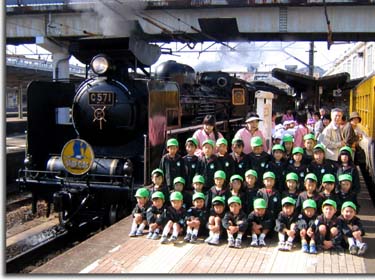 boarding. There were lots of tourists, and one thing I find to be
extremely cute - lots of grade school classes, all distinguished by
their colored hats. There was
boarding. There were lots of tourists, and one thing I find to be
extremely cute - lots of grade school classes, all distinguished by
their colored hats. There was
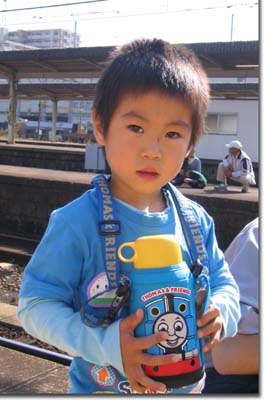 also
a young man who was definitely interested in trains! We were a bit
apprehensive about being able to get ahead of the engine, as the city
traffic was heavy, but our van driver did a great job to get us up the
line. In fact, for our first shot, we had to kill about 45 minutes
before the train showed up. That was about it, though, and we only had
one more shot at things before it arrived in Tsuwano. The engine is
separated from the cars, and turned on a turntable, after being
also
a young man who was definitely interested in trains! We were a bit
apprehensive about being able to get ahead of the engine, as the city
traffic was heavy, but our van driver did a great job to get us up the
line. In fact, for our first shot, we had to kill about 45 minutes
before the train showed up. That was about it, though, and we only had
one more shot at things before it arrived in Tsuwano. The engine is
separated from the cars, and turned on a turntable, after being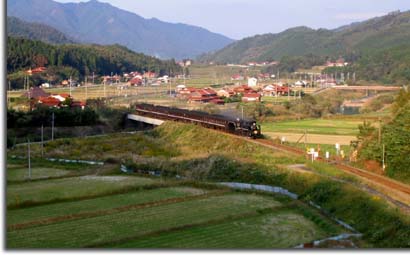 watered and fueled. And then we had two more run-bys before hitting
dense traffic again. So we got much more than I though we would. We
have the maintenance of the engine, a bit of the tourist area, some
great run-bys, coaling, the car interiors, and station material. A
couple of more shots tomorrow, and we should be done. The day starts
with a late interview though, so we shall see.
watered and fueled. And then we had two more run-bys before hitting
dense traffic again. So we got much more than I though we would. We
have the maintenance of the engine, a bit of the tourist area, some
great run-bys, coaling, the car interiors, and station material. A
couple of more shots tomorrow, and we should be done. The day starts
with a late interview though, so we shall see.
October 29
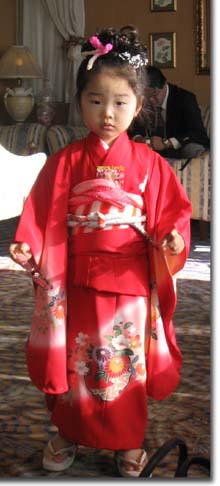 Good
news today. First, I met a very attractive young lady, who was all
decked out for Sunday. Despite her shyness, and doting parents and
grandparents, she agreed to a quick still picture. And then, our
interviewee, Mr. Yoshifumi Okuyama from JR West agreed to meet us an
hour earlier. That made all the difference in the day. He did a great
interview, and we were on the road. We had so much time that we stopped
at the Mercedes dealer to check out the new Smart models. They are
again making the roadster, which I have found very appealing. So see,
it isn't just about trains. After that it was back in the van to wait
for a passing shot at the big bridge near Chomonjyo
Good
news today. First, I met a very attractive young lady, who was all
decked out for Sunday. Despite her shyness, and doting parents and
grandparents, she agreed to a quick still picture. And then, our
interviewee, Mr. Yoshifumi Okuyama from JR West agreed to meet us an
hour earlier. That made all the difference in the day. He did a great
interview, and we were on the road. We had so much time that we stopped
at the Mercedes dealer to check out the new Smart models. They are
again making the roadster, which I have found very appealing. So see,
it isn't just about trains. After that it was back in the van to wait
for a passing shot at the big bridge near Chomonjyo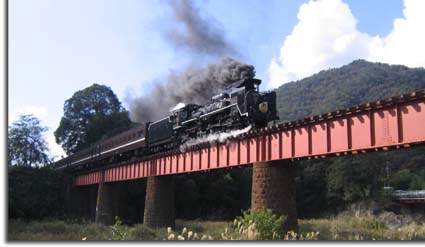 Station. We were so early in fact, that we got to stake out our spot
before the rest of the railfans showed up. And there were plenty of
them today. We got the shot, and joined the long procession of railfan
cars on the road to Tsuwano. We were able to get ahead of the train and
get on for a short ride from Tokusa into Tsuwano. Then time for some
detail on the local shrine, the Taiko-dani Inari shrine, This is one of
the five major shrines of it's type in Japan, and is dedicated to the
god of harvest. But it also
Station. We were so early in fact, that we got to stake out our spot
before the rest of the railfans showed up. And there were plenty of
them today. We got the shot, and joined the long procession of railfan
cars on the road to Tsuwano. We were able to get ahead of the train and
get on for a short ride from Tokusa into Tsuwano. Then time for some
detail on the local shrine, the Taiko-dani Inari shrine, This is one of
the five major shrines of it's type in Japan, and is dedicated to the
god of harvest. But it also
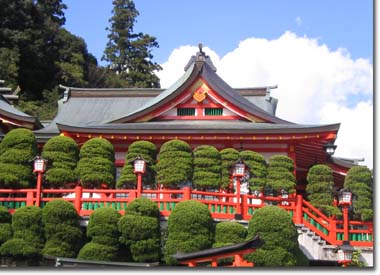 includes
the merchant and business professions as well. It is quite colorful,
and is known for the long series of gates (tori) which visitors must use
to enter. So it looks like we will catch that 5:30 train after all. And
we did, rocketing toward Tokyo at around 250 km per hour. I can't
stress enough how fast and comfortable these things are. Next stop, our
hotel in Tokyo. The German team has to shoot tomorrow. We have to go
to FedEx and fight to ship out our tapes.
includes
the merchant and business professions as well. It is quite colorful,
and is known for the long series of gates (tori) which visitors must use
to enter. So it looks like we will catch that 5:30 train after all. And
we did, rocketing toward Tokyo at around 250 km per hour. I can't
stress enough how fast and comfortable these things are. Next stop, our
hotel in Tokyo. The German team has to shoot tomorrow. We have to go
to FedEx and fight to ship out our tapes.
October 30
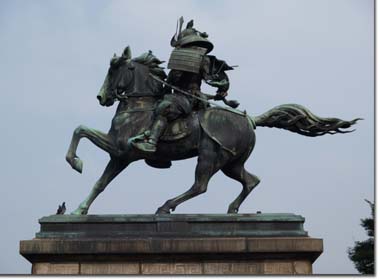 Well,
this is the last day in Japan. What are my final impressions of Japan?
Obviously, it has a great rail system. The trains are fast, clean, and
on time. But more than that, we found the people to be unfailingly
polite, and even a bit shy. When was the last time a car salesmen bowed
you off the lot when you stopped for literature? Everywhere is clean
and quiet. No gabby mobile phone talkers, no loud music. The space is
well utilized. The business hotels are small, but comfortable. The
bathrooms are small, almost like on an airplane. The population density
is large. There are people
Well,
this is the last day in Japan. What are my final impressions of Japan?
Obviously, it has a great rail system. The trains are fast, clean, and
on time. But more than that, we found the people to be unfailingly
polite, and even a bit shy. When was the last time a car salesmen bowed
you off the lot when you stopped for literature? Everywhere is clean
and quiet. No gabby mobile phone talkers, no loud music. The space is
well utilized. The business hotels are small, but comfortable. The
bathrooms are small, almost like on an airplane. The population density
is large. There are people
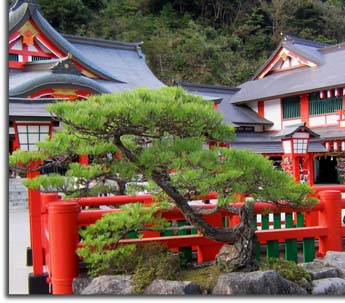 everywhere
you go. So even when you get into the rural areas, there just isn't
much wide open space. The only land that isn't built upon or used is
too steep to use, as Japan is really pretty mountainous. You will find
vending machines for practically everything, both hot and cold in the
same machine. There is technology everywhere - from the automobile
navigation systems to the heated toilet seats. The people are
industrious, and the whole society is
everywhere
you go. So even when you get into the rural areas, there just isn't
much wide open space. The only land that isn't built upon or used is
too steep to use, as Japan is really pretty mountainous. You will find
vending machines for practically everything, both hot and cold in the
same machine. There is technology everywhere - from the automobile
navigation systems to the heated toilet seats. The people are
industrious, and the whole society is
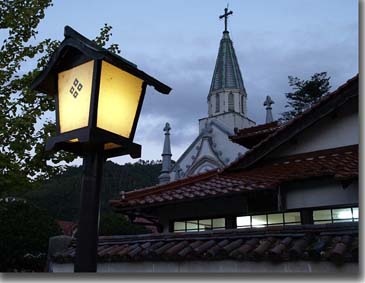 geared
toward the group, as opposed to the individual.
geared
toward the group, as opposed to the individual.
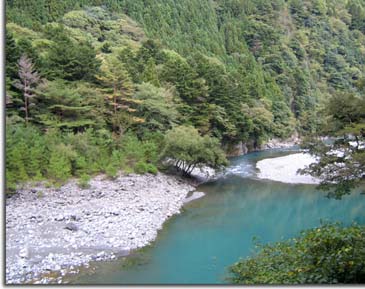
There is bright neon, high activity, cars everywhere. But there is serenity and beauty in the landscapes, buildings, and parks. The streams are clean and there is no trash or clutter anywhere. The food can be daunting and strange. There can be odd combinations, like ox tongue ice cream. But dining is easy, and the food is all good, and nicely presented. The water is drinkable. The hotels are clean and quiet. It is a beautiful county and the history, the culture and the people make this a great destination for tourism. It really is a wonderful place to see.
October 31
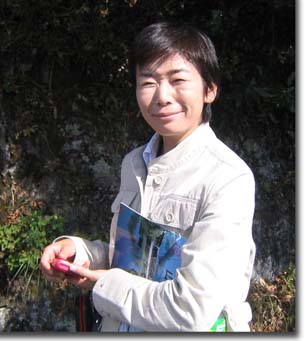 We
could not have done this trip without the support of all the drivers,
and the host of people who helped us at each and every stop of our
journey. It was all facilitated by the excellent help of
International Motion Picture, and
We
could not have done this trip without the support of all the drivers,
and the host of people who helped us at each and every stop of our
journey. It was all facilitated by the excellent help of
International Motion Picture, and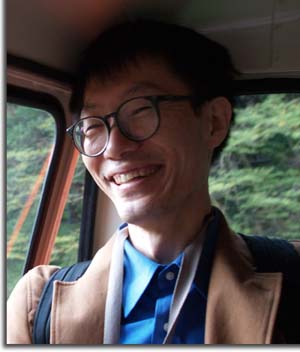 their hardworking employees, in particular Toshiko Sakaue, Akira Inoue
(for the German team) and our wonderful "fixer" Nikki Izumi. They
went out of their way to make our lives easy. And I'd be remiss if
I did not again mention the help of all the
their hardworking employees, in particular Toshiko Sakaue, Akira Inoue
(for the German team) and our wonderful "fixer" Nikki Izumi. They
went out of their way to make our lives easy. And I'd be remiss if
I did not again mention the help of all the
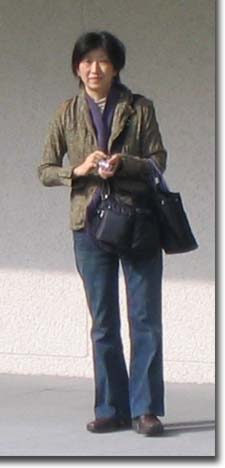 people
at the Japan National Tourist Office (New York - Marion Goldberg - and
Frankfort), the Japanese Tourism Ministry, Japan Rail, and Japan
Airlines. It has been a wonderful trip.
people
at the Japan National Tourist Office (New York - Marion Goldberg - and
Frankfort), the Japanese Tourism Ministry, Japan Rail, and Japan
Airlines. It has been a wonderful trip.
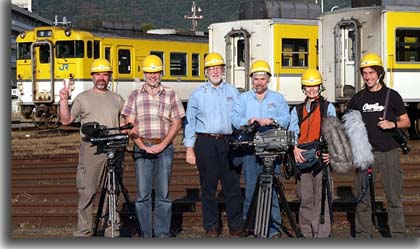
Do Visit Japan.
You won't be disappointed.
Four of these pictures were taken by Andreas Stirl.